#Maps Visualization tool
Explore tagged Tumblr posts
Text
A fantasy series where each book has the same map, but from completelly different perspective.
#writing#fantasy maps#At first people would probably be annoyed by conflicting information#but if you bring it up in the story#'You can see this is Kingdom Y's map because they always claim the border city is part of their country and not ours'#or do it long enough#it will become a nice visual story telling and world building tool
11 notes
·
View notes
Text
In today’s real estate world, everything moves fast. Buyers want more clarity, investors expect transparency, and developers need smarter ways to manage and showcase their projects. That’s where digital twin technology is stepping in to change the game. It’s no longer just about blueprints and brochures. Now, it’s about creating a live, interactive digital version of a real-world property that gives everyone involved a better experience, from planning to selling.
#3D solutions for real estate experience#3D mapping platform for real estate#interactive 3D mapping services for real estate#3D visualization solutions for property developers#virtual site tours for real estate projects#digital twin technology for real estate#web-based 3D walkthroughs for real estate#real estate experience with interactive 3D visuals#gamified property exploration tools#interactive location mapping for real estate
0 notes
Text
Networking and overcoming introversion led to a key business discovery: the power of systems and processes. Learn how mapping workflows can streamline operations, reduce bottlenecks, and optimize your business for success.
#auditing workflows#automating small business tasks#business bottlenecks#business productivity tools#business workflows#client onboarding processes#creating business systems#effective processes for small business#entrepreneur networking#improving business systems#LucidChart for businesses#mapping workflows#onboarding workflows#process automation#Process Street workflow#reducing bottlenecks in business#sales workflow audit#small business optimization#small business systems#systemizing business operations#systems and processes#visual roadmap for business#workflow audit tips#workflow mapping tools#workflow optimization
0 notes
Text
How GIS Helps in Land Use and Zoning Analysis for Better City Planning
Urban growth is accelerating, but planning for it often lags behind. One of the most common challenges faced by urban planners today is the lack of clarity on how land is being used—and misused—across city zones. Misaligned zoning laws, unchecked development, and overlapping land allocations can lead to traffic congestion, resource waste, and environmental degradation. So, how do cities solve this? This is where Geographic Information Systems step in, offering a smarter, data-driven approach to land use and zoning analysis.

Why GIS is at the Heart of Smart Zoning
GIS acts like a visual brain behind city planning. It helps planners map, layer, and analyze different types of land use—residential, commercial, agricultural, industrial—and determine how they interact. With GIS, zoning isn’t just a regulatory function; it becomes a living, evolving model that responds to physical changes.
One powerful way GIS supports this is through border intersection analysis. Imagine overlapping a city’s zoning map with its current land use dataset. You’ll instantly see where mismatches occur—for example, where industrial zones are creeping into residential neighborhoods, or where green spaces are disappearing due to unauthorized development. This makes it easier for planners to adjust policies, prioritize inspections, or even redesign city layouts more sustainably.
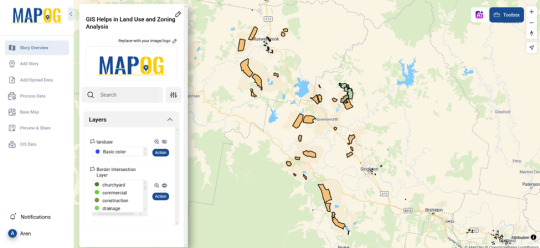
Who’s Using GIS for Land Analysis?
GIS isn’t limited to city governments. Industries like real estate, environmental consultancies, logistics, and even public health are tapping into spatial analysis to inform better decisions. A logistics company might use GIS to ensure their warehouse is placed within an industrial zone near main roads. Meanwhile, real estate developers check zoning layers before making large investments to avoid compliance issues down the line.
The Role of Platforms in Action
Platforms that support GIS storytelling and visual analysis—like MAPOG—offer an intuitive way to interact with spatial data. These tools allow users to upload zoning and land use files, perform border overlap analysis, and share the outcomes with decision-makers in a visual format. You don’t need to be a tech wizard to use them—just a few clicks, and the patterns reveal themselves.
If you’re exploring spatial zoning analysis for your city, community, or business, it’s worth trying out such platforms. They make the process more collaborative and less abstract—no more staring at spreadsheets when you can work with interactive maps instead.
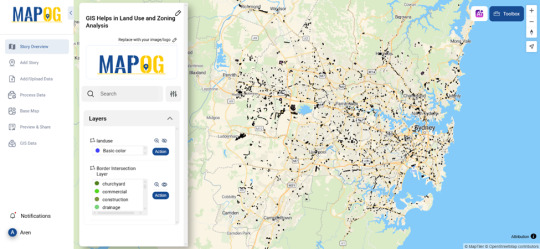
Final Thoughts
Land use and zoning analysis isn’t just about keeping order—it’s about building better cities for people, for nature, and for the future. GIS enables urban planning to be grounded in facts, not just assumptions. And with access to visual mapping platforms, anyone—from planners to citizens—can become part of the city-building conversation.
#mapog#urban planning#GIS analysis#spatial analysis#LandUsePlanning#ZoningSolutions#data visualization#gis#mapping#smartcities#mapping tools
0 notes
Text
GIS-Based Solutions for Efficient Telecom Network Management
The telecom industry is undergoing rapid transformation, driven by the increasing demand for seamless connectivity, efficient network management, and improved customer experience. As networks become more complex, the need for innovative solutions to manage these networks has never been greater. Geographic Information System (GIS)-based solutions have emerged as a game-changer in the telecom sector, offering a robust platform for managing, analyzing, and visualizing network data. This blog explores how GIS-based solutions can revolutionize telecom network management, ensuring efficiency and reliability.
Learn more at https://www.cyberswift.com/blog/telecom-utility-solution-a-brief-overview/

#gis for 5g network planning#telecom network monitoring with gis#gis for telecom service coverage analysis#gis enabled telecom site selection#gis mapping for telecom connectivity#gis solutions for managing telecom utilities#role of gis in telecom infrastructure planning#telecom utility gis software for asset management#gis technology for fiber optic network design#geospatial analytics for telecom network optimization#telecom asset management system#gis telecom utility software#fiber optic network mapping#gis based telecom service optimization#telecom network visualization tools#utility network analysis in telecom#geospatial solutions for telecom utilities
0 notes
Text

#A CEMap (Central Idea Map) is a visual organizational tool used to represent ideas#concepts#or information in a structured#hierarchical#and visually engaging manner. It is designed to simplify complex topics by breaking them into manageable parts and showing the relationship
0 notes
Text

Optimizing Networks for Efficiency: Strategies and Best Practices
In the ever-evolving landscape of telecoms, network optimization is now a focus for service providing companies searching to enhance performance and offer extraordinary service quality.
The Role of Fiber Management
Fiber Management is a cornerstone of current network optimization. As fiber optic networks become the backbone for worldwide connectivity, managing these assets efficiently is important. Fiber management is the systematic management and control of fiber optic cable, connectors and the associated infrastructure to ensure uninterrupted data transmission.
Click to read more.
Originally published: https://leptonsoftware.com/optimizing-networks-for-efficiency-strategies-and-best-practices/
#lepton maps#lepton software#gis mapping#location intelligence#fiber network#network optimization#telecom solutions#gis#maps#3d map#gis tool#data visualization#geospatial data#geo-fencing#geospatial intelligence#fiber management#fiber planner#fiber planning#fiber design#smartinventory#networkaccess#leptonsoftware
0 notes
Text
Sudokuvania: Digits of Despair is one of the most impressive works of pure game design I have ever seen.
Before I say anything else, I am going to be talking about a game that is VERY new and has pretty terrible search optimization, so in case this blog post somehow came up near the top of results for someone, here is the as-of-this-writing-current 1.02 release, and for good measure, here is the official FAQ page with the full version history, any future patches, and an FAQ for some of the more confusingly worded stuff that crops up later into the game. Now on with the praise-heaping!
So... Sudokuvania pretty much exactly what the name implies. It's a -vania, that is, a Metroidvania, and specifically one styled after one of the ones that's actually in the latter Castlevania series so that naming convention actually makes sense. Exploring a big castle, fighting bosses, getting various items letting you explore more areas, maybe breaking out of the borders of the map to find cool secrets here and there.
Also, it's a variant of sudoku. And I don't mean someone sat down with some videogame designing toolkit and made a videogame where some of the gameplay is solving logic puzzles on a grid you fill with numbers (I mean, I guess technically I do). I mean that link to the game I posted takes you to a website with a little built in standard app for solving sudoku puzzles and weird variations thereof, and the particular puzzle it's pointing to, somehow, manages to have a big map to explore, boss fights, special items that give you new powers, NPCs, and for good measure, fog of war. It is, again, an absolutely amazing hacky thing and I'm flabbergasted at how well executed it is. Now you're probably wondering how that even works, and that's why I'm writing this big gushy blog post. Here's what you see when you first load it up:

You're going to notice there is some absurdly small and kind of important text you can't possibly read, and that's because again, this is kind of a hacky thing this site so was not designed for. So it's kind of annoying but if you access this through the proper introduction page, it'll explain that the first thing you need to do is click the little gear icon in the floating tool palette, toggle on Visuals: Draw arrows above lines and Disable emoji replacement, then scroll all the way down to Experimental and turn on Test Large Puzzle UI. That enables you to zoom in and out with the scroll wheel, and right-click drag to pan around. It's... a little clunky because again, this website was NOT built for this, but tada, now you can zoom in, read the text, and start solving at a reasonable size. Then there's a couple gameplay concepts it does its best to explain, but... most people I've shown it to myself included needed extra explanation of a couple important early concepts. So let me just do a little color coding here to make this easier to get...

The map is not, in fact, one great big grid. It's 9 squares (and one rectangle that's not quite square over on the east side). Each of these is its own 9x9 Sudoku grid (well, the starting one is 6x6 and has those mutant 2x3 cells instead of the usual 3x3, and there's that weird eastern mutant). If you're solving stuff in one square, you completely ignore everything outside that square, except for where they overlap, in which case the numbers you're placing have to fit for both puzzles. So if we look at the light grey/green intersection on the left, those three overlap cells respectively can't be 4 6 or 5 (and whatever use you deduce in the grey box, but the pure green cells completely ignore all that, you're just focusing on the green 9x9 (which is going to have the overlap as a starting point, naturally).
The next bit that through me off a ton is the way fog of war works. Let me reasonably zoom in and do a little solving here. One second...

Here's the whole starting area all marked up to hell like you do when you're kinda bad at Sudoku and don't know how to spot a starting point. Penciling in little numbers in the corners. You'll also notice a that... most of the map is covered in this dark grey fog of war. A lot of in-game stuff mentions that you shouldn't go clicking out into the fog of war, because it'll show you names of later areas and preview certain special rules and all, but that's talking about clicking WAY off from what you can see. You are 100% allowed to solve stuff out in the fog of war, and it's pretty stingy about de-fogging. Don't go blindly guessing because then you can maybe end up sequence breaking but... yeah. Sorry I'm spoiling the Front Gate, it's basically the tutorial though. Anyway, first move is obvious, only one place we can put that 6, and suddenly...

Tada, important space so it rewarded us with a little fog clearing. You can also see that this will handily point out stuff in your pencil notes that can't be true, but only if A- it's untrue for standard sudoku reasons not special stuff, and B- it's not in the fog of war (or on the other side of some. You also maybe noticed that weird green thing under that first hint 6? That's something we need a tool for, you don't worry about it until you have that tool. Solving this out some more...

Little more de-fogging, both of the puzzle area and the margins where we're getting new information on playing the game in general. Now right here if you're observant, you'll see that bottom right corner has to be a 6. It's out in the fog of war, but you can mark it if you know what it is. And...

I was cropping it out before but the big purple number pad is always floating off to the side there, and the green text box over it, which among other things has an area name and flavor text for whatever grid you're in. This won't ALWAYS happen when you place numbers in fog of war, but there was a trigger on this 6 to load in a little piece of the first real area, and oh hey, we unlocked "Guide THERMO!" That's our first tool, and it's described up in the upper left.

So tada, from here out in addition to standard sudoku stuff, you've got these "bronze Guide THERMOs" that show up here and there and have this extra rule. You basically never get free numbers in the grid past the Front Gate, it's all slow-marching into new areas using what you're bringing in plus some easy starting examples of how your new tools work, plowing on from there. The fog of war is pretty stingy but it keeps you focused. You'll also notice the rules here mention bosses, all the 9x9 ones have one. It's clearly marked, and you should PROBABLY expose it from the fog first, but any time you're in the area really you, if you scroll around in that green text box or hit the rules button when in a grid, there's a link you can click to go fight it. The boss fights are all separate puzzles (site's good about auto-saving so don't freak out if it takes over your tab and you have to hit back after). These are very themey, sometimes VERY evil (especially boss #1, feels a bit overtuned) self-contained 9x9 puzzles, probably using the same tools their area is themed around, and I don't think there's a single pre-placed number in any of them. Beat the boss puzzle, it gives you some flavor text and a number to place in its cell back in the main castle puzzle, plug that in and you're always going to unlock something cool. Usually a new item, sometimes other weird stuff, and it just goes on like that.
Don't expect to be able to fully solve a given grid in one go. It's a Metroidvania, backtracking is expected. Even if you've fully de-fogged a grid, later stuff might reward you by straight up adding new symbols you couldn't see before or doing weird stuff with fog. It IS all solvable with pure logic... but there ARE a few places that do that thing I hate in tougher sudokus where you just kinda have to pencil in in a different faction and explore 2 possible futures for a bit to see which eventually contradicts itself. And of course the last couple of grids do some really evil mind-bendy stuff.
But yeah aside from a couple gripes where the way a tool works could maybe be a lot more grammatically clear, that first boss being a lot to deal with as you're first getting your feet wet, and a particularly cruel twist later on, I don't really have any complaints. Well, it might need a cool soundtrack. Maybe play some Castlevania music. Maybe switch it up for some real proper boss music when you're nearing victory.
youtube
Again I am just completely blown away that someone made something so meaty in a standard sudoku site's normal UI, and really managed to make it feel so much like playing a DS Castlevania. Some real proof of game design being an art form here. And now you too can just completely lose a day or two to it!
#Sudokuvania#Metroidvania#Castlevania#sudoku#game design#puzzles#sudokuvania digits of despair#yes there's wall meat of course there's wall meat#Youtube
2K notes
·
View notes
Text
How to Stop Procrastinating by Managing Your Emotions
Procrastination happens when we delay doing things, and it's often connected to our emotions. Feelings like being afraid to fail, feeling worried or stressed, getting bored, or lacking motivation can all contribute to procrastination. To stop procrastinating and get more things done, it's important to learn how to handle our emotions better.
Boredom:
Break the task into smaller, more engaging sub-tasks.
Find ways to make the task more interesting or challenging.
Set a timer and work on the task for a specific amount of time, followed by a short break doing something enjoyable.
Feeling Overwhelmed:
Prioritize tasks and focus on one thing at a time.
Break the task into smaller, more manageable steps.
Delegate some parts of the task if possible or seek help from others.
Use tools like to-do lists or task management apps to stay organized.
Anxiety:
Practice deep breathing or mindfulness techniques to calm yourself.
Challenge negative thoughts and replace them with more positive and realistic ones.
Start with the easier or less intimidating aspects of the task to build momentum.
Set realistic expectations and remind yourself that it's okay to make mistakes.
Self-Doubt:
Focus on past accomplishments and successes to boost your confidence.
Seek support or feedback from others to gain reassurance.
Remind yourself of your skills and capabilities to tackle the task.
Use positive affirmations to counteract negative self-talk.
Perfectionism:
Embrace the concept of "good enough" rather than seeking perfection.
Set realistic and achievable goals for each task.
Recognize that mistakes and imperfections are part of the learning process and growth.
Indecisiveness:
Break decisions into smaller steps and make one small decision at a time.
Set a time limit for making decisions to avoid overthinking.
Trust your instincts and make the best decision you can with the information available.
Apathy or Lack of Interest:
Find aspects of the task that align with your values or long-term goals.
Break the task into smaller, more manageable parts and focus on completing one at a time.
Reward yourself for completing the task to make it more appealing.
Stress or Burnout:
Practice stress-reduction techniques such as meditation, exercise, or spending time in nature.
Break tasks into smaller steps to reduce the feeling of overwhelm.
Prioritize self-care and take breaks to avoid burnout.
Feeling Uninspired or Creatively Blocked:
Engage in activities that stimulate creativity, such as brainstorming, mind mapping, or seeking inspiration from others' work.
Start with a simple and basic version of the task to get the creative juices flowing.
Collaborate with others or seek feedback to gain new perspectives.
Fear of Success:
Identify and challenge the negative beliefs or fears that may be holding you back.
Visualize the positive outcomes of completing the task successfully.
Focus on the benefits and personal growth that come with success.
Impatience:
Break long-term goals into smaller milestones to track progress.
Practice mindfulness to stay present and patient throughout the process.
Remind yourself that progress takes time and effort.
Lack of Confidence:
Celebrate your past accomplishments to boost your confidence.
Seek support and encouragement from friends, family, or mentors.
Focus on building specific skills related to the task to increase confidence.
Avoiding Discomfort:
Acknowledge that discomfort is a natural part of growth and improvement.
Break tasks into smaller steps and tackle the more challenging aspects gradually.
Remind yourself of the long-term benefits of facing discomfort.
Overestimating Future Motivation:
Practice discipline and commit to starting tasks even when motivation is low.
Set specific deadlines for tasks to create a sense of urgency.
Establish a routine that includes regular work on the task to build consistency.
#discipline#motivationalquotes#motivateyourself#get motivated#organization#procrastination#emotional intelligence#self improvement#selfimprovement#self love#self development#personal improvement#personal growth#personal development#level up journey#success mindset#positive mindset#business mindset#goalsetting#life goals
9K notes
·
View notes
Text
been messing around with making a (faked, actually 2D) 3D dungeon crawler without a game engine the last few days - never tried making anything in just C# and monogame with visual studio before, its like a fun puzzle…
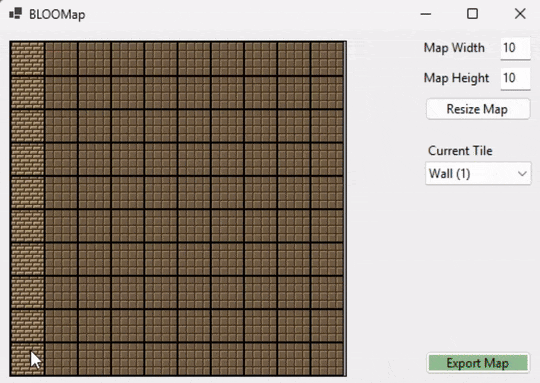
simple little external tool for making the number arrays that generate the maps I put together today, haven't done much like this before either so it's fun, idk how I'd do something like this as simply in unity lol
1K notes
·
View notes
Text
If we talk about the aesthetics of technology in Lancer, we can divide each of the Big 4 along lines of form and function.
IPS-N: Pure Function
IPS-N cares only what a mech does. It doesn't need to look good or pretty doing it - it only needs to be able to do that thing well. It's notable that the Raleigh, arguably the most form-oriented of the IPS-N frames, is also considered to be the company's biggest commercial failure - they strayed from their core design principles and got punished for it.
Harrison Armory: Form Follows Function
Harrison Armory still leans pretty heavily towards the functionality side of things, but it isn't satisfied with doing a good job alone. Yes, the mechs have to perform well, but they also have to look good doing it. There's no practical application for the Sherman's sleeveless coat or the Tokugawa's dainty little tassels, but they don't hinder combat functionality and they make the mechs look dashing. In comparison to IPS-N's coarse, industrial, almost unfinished look, HA mechs look stern, austere and imposing. There's a smoothness to them that you just don't get on IPS-N frames.
SSC: Function Follows Form
SSC is where we start to plunge into aesthetics-forward mech design. The Death's Head isn't six-legged because it's a sniper - the Death's Head is a sniper because it's six-legged. SSC came up with a mech design and asked: "what would this do best?" A six-legged chassis provided a more stable firing platform for precision weaponry, so that was what it did. Shapes and appearances are invented, and then a use case is discovered for them.
HORUS: Pure Form
It might seem weird to classify HORUS as "pure form" when their mechs largely don't have a consistent visual identity outside of the examples in the book. However, if we look a little deeper at the definition of "form," the explanation becomes clear: in some ways, HORUS is in the business of making statements, not mechs.
For anyone who's actually played a HORUS mech in Lancer, you may have noticed how awkward they are to actually pilot. Their statlines are, on paper, often very poorly suited to the sort of work they have to do. The Gorgon is built to attract attention and draw fire but has no armor. The Manticore is meant to be a front-line fighter but is quite slow. The Minotaur is meant to be a tech platform but has a low sensor range. The Pegasus' one functional trait doesn't apply to any of the weapons in its equipment package!
This is because HORUS mechs are designed purely as a testament to a certain discipline of technology. I remember expressing irritation with a friend's NeoGeo-for-X-Box emulator once, that you couldn't reconfigure the controller mapping so that it was easier to play with the X-Box controller. He remarked that it was meant as a historical preservation tool that perfectly duplicated the functionality of the NeoGeo, and that the only reason you could even play games using it at all is because that was a function of NeoGeo arcade cabinets.
That's how HORUS mechs are - their usability as chassis is broadly a side-effect.
#ips-n#harrison armory#smith-shimano#ssc#horus#lancer#lancer rpg#lancerrpg#lancer-rpg#in golden flame#design aesthetics#form vs function
972 notes
·
View notes
Text
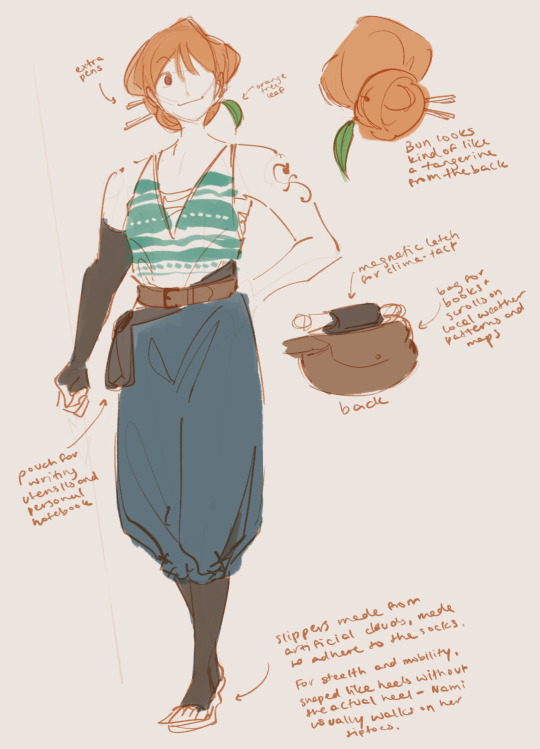
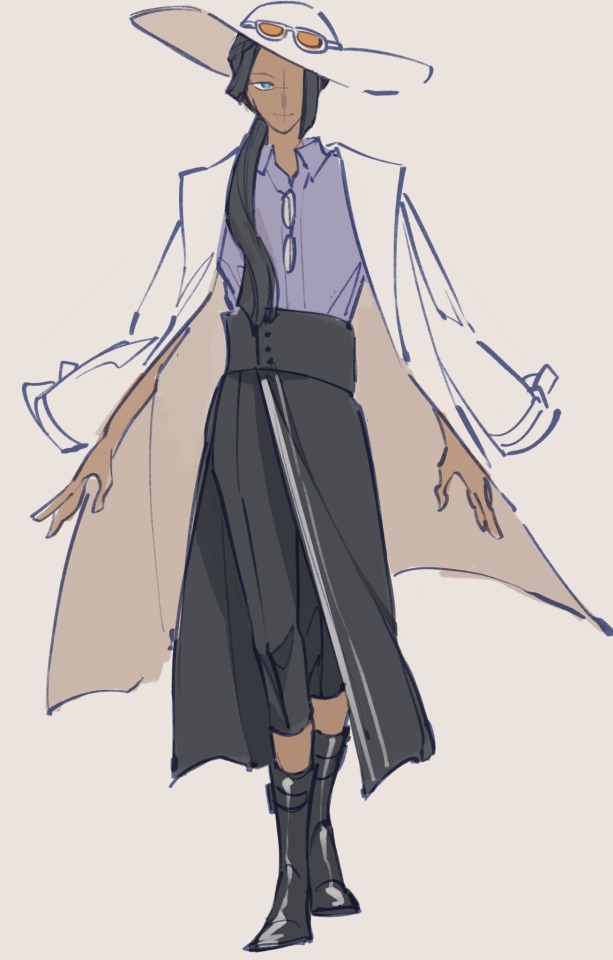
Straw hat women redesigns :) I was trying to doodle some of the crew and came to the realization that I just Could Not with Nami so I wanted to play around with it a little bit
Some more design notes below:
Nami’s design actually went a lot smoother for me than Robin’s! I think canon post timeskip Nami is a very low bar. While you can argue that to some extent Nami being vain and seductive is part of her character, I do feel that there are many more integral parts of her character that can be highlighted in her design, namely map making and her combat. Though not one of the stronger straw hats, Nami does seem to be well practiced with her staff outside of its use for weather manipulation, and I think her being a physical combatant, even slightly, can be better reflected with more loose clothing for better mobility.
For her mapmaking, I wanted her to have constant easy access to her tools and to information about the locale, so around her waist she has one large pouch at the back for books and scrolls and maps in progress and one small pouch to the side for writing utensils and measurement tools. As backup she also has 2 pens in her bun, which also act as pins for keeping her hair up if she ever needs to move a lot.
I’m not sure how clearly it shows up in the notes, but Nami’s shoe soles are also made from whatever artificial cloud material makes up the weather island she stayed on during the timeskip, so that it both pads her steps to make them soundless and bounces for better mobility. The shoes are naturally shaped like heels but without the actual heel, since she tends to move around on tiptoes anyways- a nod to her epithet as cat burglar and her past as a thief.
I made her shoulders a bit broader because I think they probably get a lot of exercise with her staff, and changed out the bikini top for a more supportive chest wrap, with a loose tank over it for breathability. The compression socks and sleeve are more stylistic than anything, since I like layers, but they might come in handy for her if she spends extended amounts of time sitting down making maps for the crew.
Robin’s was a bit more difficult for me to figure out, and I might go back and revisit it at some point. For Nami, it was a bit easier to imagine what would pair well with her combat methods and her needs as a mapmaker, but with Robin, she’s an academic who fights almost completely hands off, without a specific weapon to her name. Because her strength lies mostly in her devil fruit, she has a bit more room for style over functionality, but I also still wanted her to have something that made sense with what she was. I don’t really think I succeeded in that regard, but it’s also hard to convey what she does visually— she’s more of like a professor than a field archaeologist I think.
I really really enjoy her cowboy hat but I didn’t think it would match with the rest of the outfit so I switched it out for a wider brimmed hat and kept the orange sunglasses on it, as a nod to the revolutionaries with the combination of headwear and eyewear. She deserves a trench coat. I don’t make the rules. And the rest of the fit mostly came down to things I think I would enjoy wearing, haha
The trench coat is partially a nod to the scholars of ohara, who seem to wear white coats like lab coats in some screenshots of robin’s backstory. I think also the reading glasses help to make her seem a bit more academic, but aren’t prominent enough to leave a strong impression. All in all I do wish robin’s design had more functionality in it but I also think that robin is a character who probably enjoys dressing up nicely like this, especially in the comfort and stability of the straw hats.
1K notes
·
View notes
Text
virtual site tours for real estate projects | Propickle
Propickle offers immersive virtual site tours that bring real estate projects to life. With 3D walkthroughs, interactive features, and high-definition visuals, Propickle helps developers showcase properties remotely and enables buyers to explore every detail—from floor plans to finishes—anytime, anywhere.
#digital twin technology for real estate#web-based 3D walkthroughs for real estate#real estate experience with interactive 3D visuals#gamified property exploration tools#interactive location mapping for real estate#3D solutions for real estate experience#3D mapping platform for real estate#interactive 3D mapping services for real estate#3D visualization solutions for property developers
0 notes
Note
Hi! My friend is a big fan of your art, and they asked me to ask you for tips on how you draw hair. I'm no artist, so I probably shouldn't be the one to ask these questions, but would you mind sharing a few suggestions? Any pointers about your character designs or your art style would be greatly appreciated. Thanks so much, and hope you're having a good day! <3
Hiya!! I tried to breakdown my approach to drawing hair here, but these are by no means hard and fast rules! Hope this helps :)
1: The Hairline
I usually start with the hairline. I like to break it down into 4 main sections, that I can play around with:
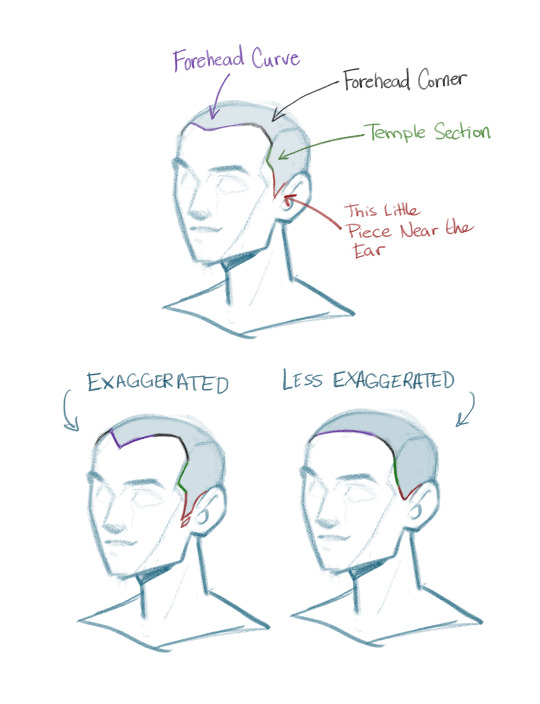
I like to try to line up the temple section with the ridge of the side plane of the head
Try to have the hairline follow the natural flow and planes of the head
There's a gap between the hairline and the ear (often it gets covered up by longer strands of hair, but if you're drawing a short cut or pulled back hair, you'll probably see it)

2: The Silhouette
I like to draw out the silhouette next. Sometimes I'll use the lasso and fill tool, so I don't get wrapped up in extraneous details.

Try focusing on finding an appealing shape for the hair, and how it will frame the face
Consider how thick you want the hair to be and it's texture
(I find this is also a good time to flip the canvas to make sure the weight feels balanced)
Try to avoid having tangents with facial features, if you're drawing bangs or face framing pieces
Keep in mind how outside factors may affect the hair (like if there's a breeze, or if the character is lying down, or if they've tucked a piece behind their ear, ect.)
Try to keep shape variation in mind. A small shape next to a big shape is often more appealing than 2 medium shapes side by side
I also like to play with a lot of straight/curved line variations to make the shapes look interesting
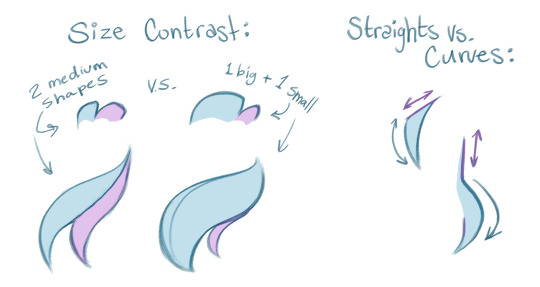
3: Flow & Volumes
(I usually just visualize this step, rather than drawing it out like this)
Basically try breaking down your silhouette into big volumes, and know where the hair pieces coming from and where they're going.

^For example, the hair on top, is brushed froward, with no defined part, so the chunks that we can see start at a cowlick at the back of the head and spiral out from there. The hair on the bottom however starts at the part, shwoops up, and then cascade down in 2 layers.
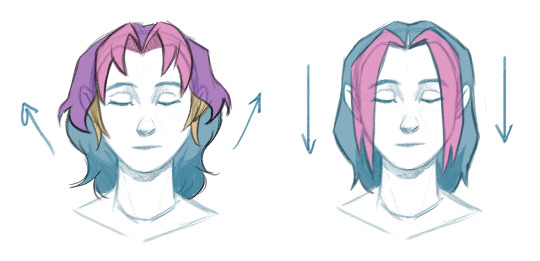
^Another note: more layers usually means more volume wherever the layers are placed, longer hair pieces will weigh the hair down, meaning less volume.
4: Details
Once I have an idea of what the hair is doing, I draw out the chunks of hair, following the volumes and flow I've mapped out. Sometimes I'll do a little bit of hatching to indicate volume or texture.
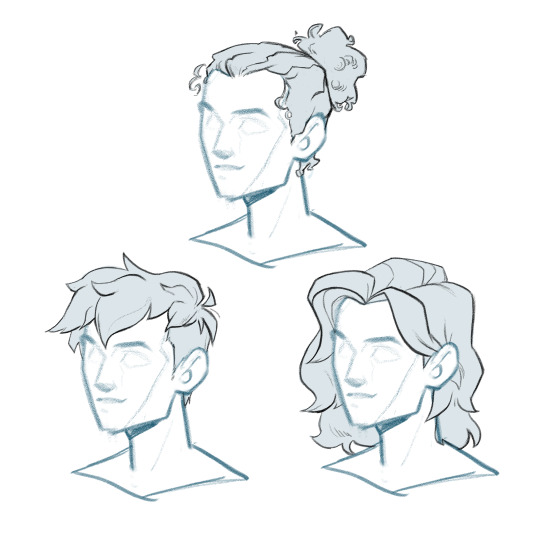
I often like to choose 1 or 2 shapes for my clumps, based on the hair texture, and then repeat those shapes throughout:
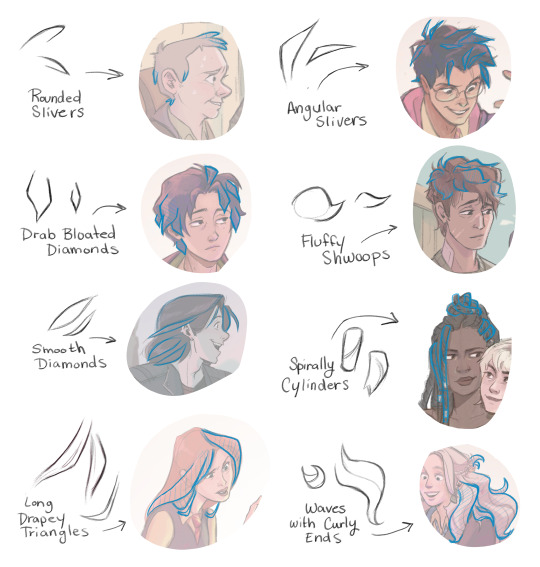
Vairy the size of your clumps
Beware of overworking it at this stage, sometimes less is more yk? And too much detail near the face can be distracting
Make lines on the silhouette and lines closer to the front thicker (especially if it's overlapping another line)
You don't have to draw every strand. Sometimes I'll break up big clumps with a thinner inner line, but I try not to go overboard with this. You can also indicate strands by adding little cutouts to the silhouette, like this:
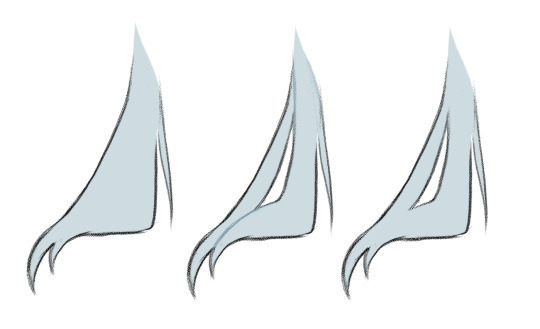
5: Rendering
My process for rendering hair is pretty much the same as it is for anything else. Base colour layer>shadow layer>highlight layer.

I like to use the lasso/fill tool here again for shadows, and then soften them up a bit by going over some of the harsh lines with a pencil brush
For shadows, I usually just do a multiply layer with a lowered opacity, clipped to the base colour layer and then use a bright red or purple colour
Highlights and shadows can also be used to indicate more hair clumps that you haven't drawn in
Try to think of the shadows as big graphic shapes, that fall where the light won't hit, and wrap around the forms of the hair
I personally don't like to go crazy on the highlights, but when I do, it's usually for dark hair, since shadows don't show up as well on darker hair
Shiny glossy hair, usually has brighter highlights with harsher edges
Also black hair isn't usually pure black unless it's a stylization thing or the lighting is reeeally dark
Sometimes once I fill in the hair, I'll look at it and go "ew why's it look dumb now?" Sometimes the warp or liquify tool can help with refining the proportions to rectify this and sometimes you just have to cut your loses and redraw stuff :P
Then as a final touch a may add a few stray strands of hair that break off from the main shape
Ok that's all! Hope your friend has fun drawing hair! Have a great day <33
249 notes
·
View notes
Text
semester success. ᥫ᭡
[ 3 chapter mini series ] | chapter one
in this series, i’m going to teach you all my helpful tips and tricks on how to succeed in the new semester in just 3 quick chapters! get ready to take notes, we’re diving right in!
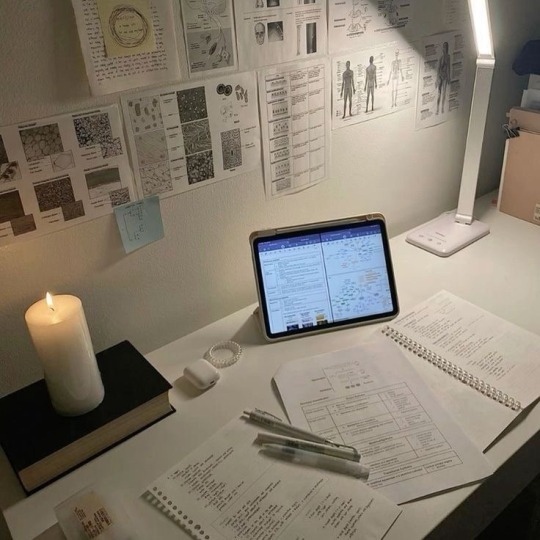
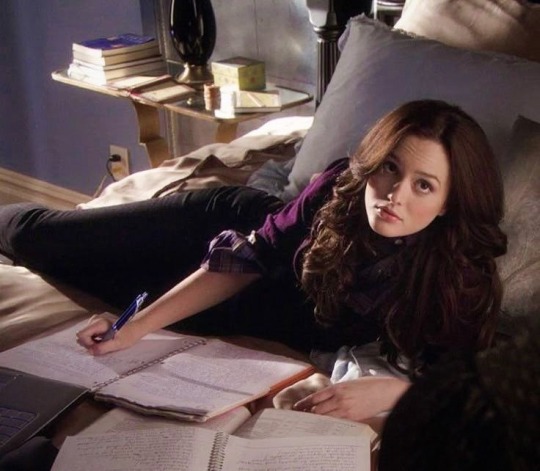
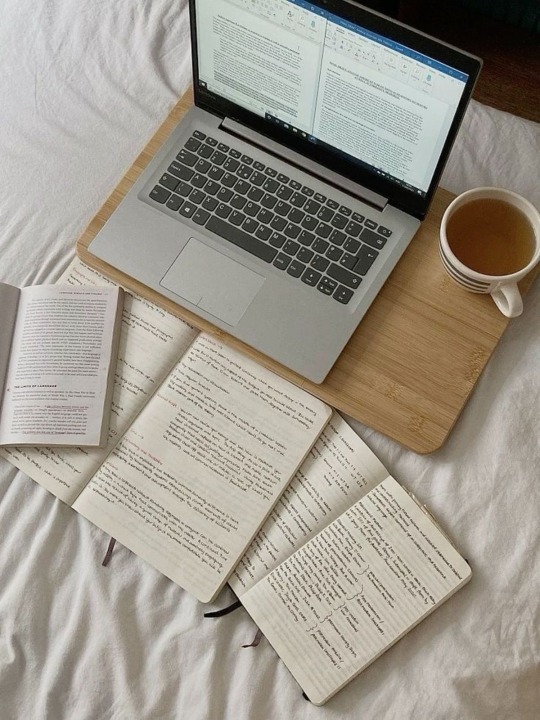
chapter two — MASTERING NOTE-TAKING
in the last chapter, we talked about the first week and how to prepare for it! now, we’re going to get real into it and talk about one of the most important skills that can help increase your level of success throughout the semester: taking notes.
class is in session …
୨ৎ — physical or digital
let’s first decide how we’re going to take notes. if you’re the classic/traditional type, a notebook & some pens/pencils & highlighters are the way to go! but if you’re feeling a bit more modernized, grab your laptop and/or tablet!
i personally use my ipad to take notes! i know lots of people who use Notion, create digital documents for their notes, utilize GoodNotes/Notably, and i use this app called CollaNote (more on this later)! if you’re note-taking digitally, find an app or format that works best for you! you can play around with the different apps and tools on your device! digital note-taking also allows for more creativity, in my opinion, but i’ve seen loads of students get really creative with traditional styled notes!
digital note-taking inspo:
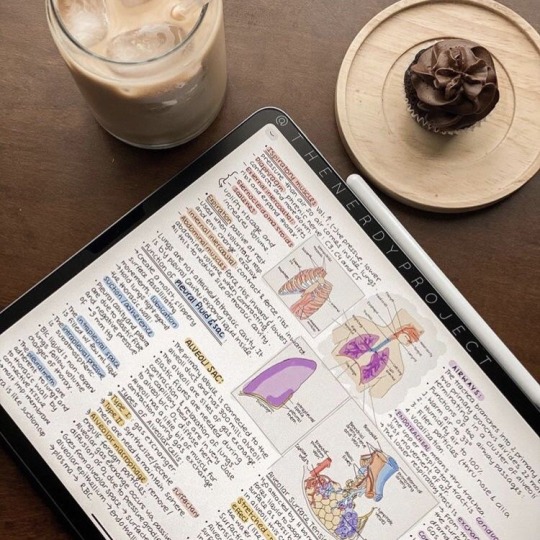
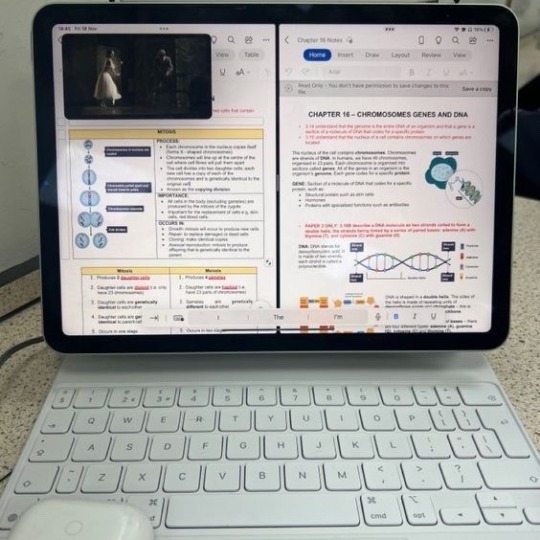

i highly recommend this post by @glowettee if you want a quick, but detailed list of how to get set up for digital note-taking!
physical note-taking inspo:
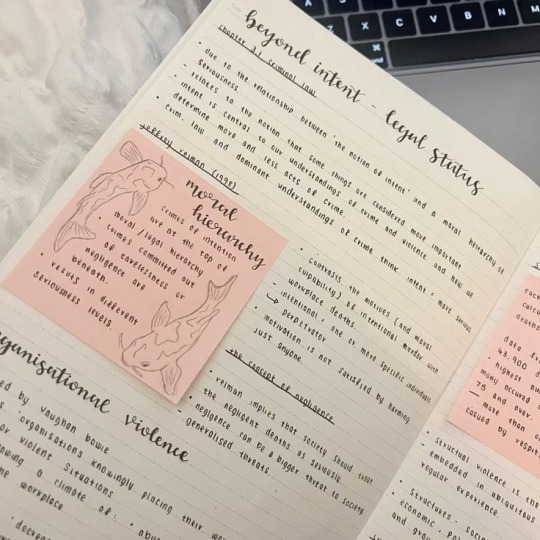
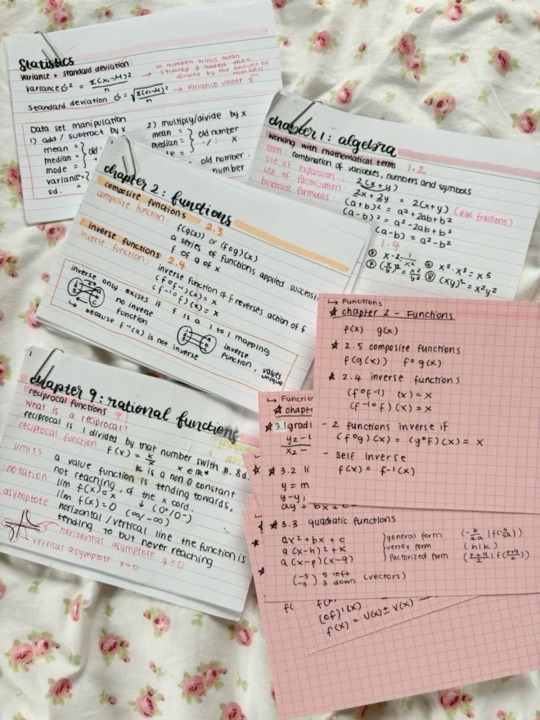
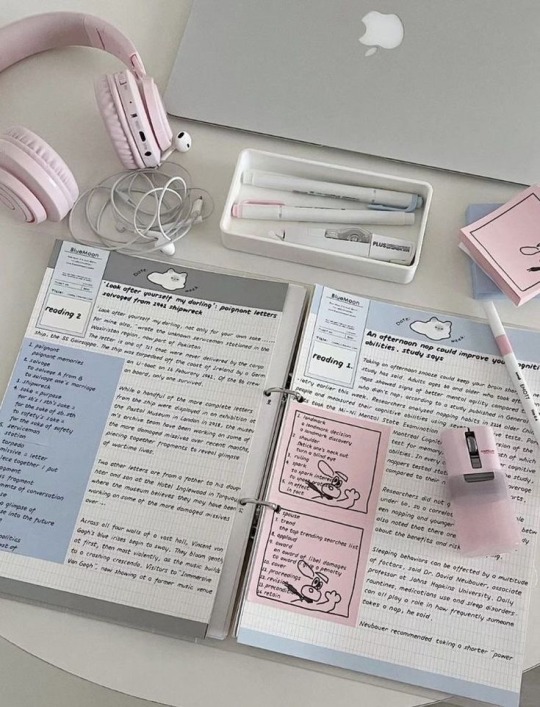
୨ৎ — note-taking methods
there’s lots of ways to take notes! that’s the beauty of note-taking, there’s no one right way of doing so or any wrong way of doing so! there’s a variety of ways to take notes, so find and play around with what works best for you!
different methods:
quick notes - the unaesthetic version
you’ll see lots of people say that they rewrite their notes, and i’m one of those people! i typically don’t take notes during lectures (mainly because my ADD doesn’t allow me to lol) but when i’m actually able to take some notes, my in-class writing is just plain bullet points and words scrambled onto my page.
i see “quick notes” as a way of making sure you get all the key points from the lecture without the stress of writing everything else down.
here’s how:
don’t focus on writing every single thing down! this will make you lose track of what the professor might be saying in addition to what’s in the textbook/lecture slides.
focus on the key points! keep an ear out for your professor and if they say something like “this will be on the exam” or “this is really important to know”. those are the things that need to be written down!
remember: you can always go back and rewrite your notes! having just the key points written down will help you 1. stay focused during class and 2. be prepared for what to focus on during your studies.
don’t worry about your notes looking bland or messy, again, you can go back and rewrite your notes to make it look nice and add additional information! this “quick notes” method is for people who are like me and struggle with taking notes during lectures!
** tina’s tip: record the lecture! if you’re able to have your phone out or if your computer/tablet has a recording feature, use it to record the lecture so that when you do go back to rewrite your notes you don’t forget any other important points!
mind-mapping - an organized flow chart
how it works:
start with your central idea or main topic you want to focus on! have this be the center of your mind-map.
when info regarding this topic starts to come up, write them down and connect that additional information with the central idea using lines and arrows.
get creative! use different colors and add images or symbols!
mind-maps are a great way to organize and visualize the information you need to do into a creative diagram! this is a great method for those visual learners!
boxing method - compartmentalizing notes
this method is another great one for visual learners as it allows you to create a chart for yourself and all that you’re learning in class!
how it works:
start by dividing up your page so that you have different boxes set out for you!
include headings/titles for each box and have them relate to each topic you’re learning.
in those boxes, write down key points from each topic and include any and all information as you can!
you can also connect the boxes with lines and arrows to see how all that information flows together and relates to one another!
i suggest going onto @nenelonomh ‘s blog and reviewing her study corner where there’s a section dedicated to different note-taking methods! as well as other helpful academic advice!
୨ৎ — record your lectures
i mentioned this earlier, but i just want to reiterate this point! recording lectures will help you so much with note-taking as it allows you to go back to what was said in class and continue taking notes that way. it’s extremely helpful especially when your teacher/professor is a fast talker and you can’t keep up with note-taking in class!
୨ৎ — color coding
an easy way to make your notes more appealing to you is by color coding everything! feel free to pick your favorite colors and use those!
what to color code:
key points
important vocab/terms
connecting topics
additional notes from your teacher/professor
୨ৎ — CollaNote
i promise this is entirely unsponsored, but i do love this app! it’s completely free (with in-app purchases if you want to unlock other templates)!
it comes with a variety of free tools, pen styles, highlighters, colors for those writing tools (which are also entirely customizable!), page templates, recording feature, and so much more that i can’t fully remember off the top of my head!
it also allows you to organize everything into folders which is really, really nice! organization of your notes is also super important when it comes to note-taking! so let’s get into organization!
୨ৎ — note organization
if you’re taking notes in the traditional way, make sure you have designated notebooks for each class. if you’re using a binder that includes all of your classes, make sure you have those divider tabs to prevent from any of your notes integrating with your other ones!
for digital notes, make sure you have folders or an organized list of links for each of your courses! it’s important that your files are titled accordingly so that there’s less confusion when you need to go back to any of your notes!
going back to note-taking methods, make sure when you’re writing your notes that you stay consistent with your organization!
write your topics in chronological order
create sections for different bits of information
color code
you don’t want your notes to be a jumbled mess! not having some kind of organization system can lead to confusion while studying or unclear information on the topics you’re learning.
before you’re dismissed …
note-taking, as i mentioned at the beginning, is one of the most important skills to have while in school. you want to make sure you have effective notes that will help you understand the material and help you study for upcoming quizzes/exams! just imagine yourself as the main character in a show or movie and think of yourself as this studious and amazing person while taking notes and sitting through lectures! romanticize your academic career!
with lots of love, faustina 🌷
#milkoomis#girlblogger#girlblogging#it girl#that girl#becoming that girl#becoming her#it girl tips#studyblr#study tips#study productivity#study movitation#note taking#study notes#school tips#school motivation#light academia#dark academia#academia aesthetic#academic motivation#self improvement tips#self improvement
264 notes
·
View notes
Text
So... what exactly are executive functioning supports...?
Planners, checklists, and reminders are definitely executive function supports, but they aren't the only things that are available. ...so, I've made a list of some examples. A thread (🧵)
Executive functioning includes so much, so executive function supports can be SO MANY things. Executive functions include decision making, working memory, task initiation, planning, prioritizing, many forms of self-regulation, and more.
So let's talk in broad categories
Category 1: Decisionmaking
Avoiding a decision altogether,
Choosing randomly,
Reducing the number of options to decide between,
Always doing the same decision (such as having a uniform for yourself),
Outsourcing decisions,
Having outside structure/expectations
Category 2: Working memory
Keeping things visible,
Reminders,
Collaborators who gently remind you of things,
Writing it down (i.e., notebooks, post-its, to-do lists, etc.),
External structure such as lunch hours,
Understanding why and how working memory fails
Category 3: Information processing
Avoiding weak processing areas (eg. reading for dyslexics like me)
Have information in multiple forms,
Make information processing context relevant,
Reduce incoming information or competing demands
Category 4: Task Management
Body doubling,
Transition time,
To-do lists,
Breaking tasks down (including people to help with that),
External structure for identify the next step,
clear, explicit instructions,
Schedules, planners, itineraries.
Category 5: Organization
Mind maps,
Labels,
Notetaking templates,
Physical organizers,
Organizing methods (Kondo, Only 4 Things, etc.),
House cleaners, professional organizer, etc.
Clear bins,
An ability to toggle visibility
Category 6: Cognitive Flexibility
Transition time,
Pre-change warnings,
External support for identifying and reminding the new direction,
Context-based exemplars of similar change,
Visual schedules,
Reminders of when structure will start again
I've listed a lot of things here, but there are just so, so, so many more options.
Executive function supports can be ways that we think or approach situations (internal) or structures imposed on us by others (external). They can be physical tools that we can touch and interact with (tangible) or completely abstract ideas or approaches (intangible)
The big takeaways are that executive function supports can be any tool, structure, or communication that supports any of our executive functions.
Executive functioning struggles are core to the ADHD and autistic experiences (and secondary to other ND conditions). This means executive functioning takes a lot of energy for ADHD and/or autistic people, and the more support we have the more energy we can use for other things
So, yeah, planners, checklists, and reminders are definitely executive function supports, but so is a highschool bell schedule, hobby-related groups, professional services, and colleagues (consensually) harassing you to remember to send that email.
There are a lot of options!
#adhd#executive function#executive functioning#coping#coping strategies#autism#task initiation#decision paralysis#actually autistic#neurodivergent#mental health#executive dysfunction
2K notes
·
View notes